 Stars and ShearwatersThursday 4th May 2000 THERE'S A COOL BREEZE so I keep to the shelter of various bird hides for much of the day.
THERE'S A COOL BREEZE so I keep to the shelter of various bird hides for much of the day.
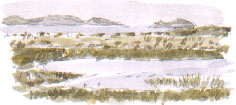
 
Crab Bay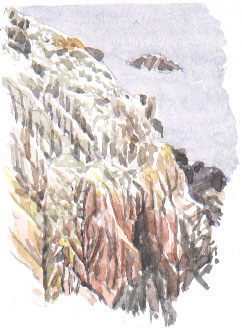 You're surrounded by colour on Skokholm. On other coastlines limestone or chalk cliffs may form a subtle monochrome backdrop but, on this island, the Devonian desert sandstone is red, spattered with orange-yellow lichen.   Looking down into the bays, the sea seems a purer turquoise than on our North Sea coast back in Yorkshire. The theme of pure colour is taken through to details like the beak of the Herring Gull; yellow with a scarlet patch. Looking down into the bays, the sea seems a purer turquoise than on our North Sea coast back in Yorkshire. The theme of pure colour is taken through to details like the beak of the Herring Gull; yellow with a scarlet patch.
Shearwaters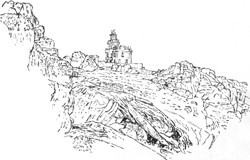 As it is light until 9 o'clock, I decide that, during my all too brief stay here, I will miss out on the daily bird log and the evening conversation around the log fire in the centuries-old farmhouse. Instead I take one last quick circuit around the island. Then, as it gets dark, there's time for a cup of tea by the fire, but that isn't the end of birdwatching for the day. We go out each night to watch and listen to the spectacle of the Manx Shearwaters (below, right) returning to their burrows. The numbers begin to build up around 10.45 and, apparently, there is a lot of coming and going until about 3 a.m.. Apart from the nesting period, shearwaters spend their lives at sea. If you take the track to the lighthouse, about a mile's walk, you can see the returning shearwaters picked out in the rotating beams of the light. We see their
As it is light until 9 o'clock, I decide that, during my all too brief stay here, I will miss out on the daily bird log and the evening conversation around the log fire in the centuries-old farmhouse. Instead I take one last quick circuit around the island. Then, as it gets dark, there's time for a cup of tea by the fire, but that isn't the end of birdwatching for the day. We go out each night to watch and listen to the spectacle of the Manx Shearwaters (below, right) returning to their burrows. The numbers begin to build up around 10.45 and, apparently, there is a lot of coming and going until about 3 a.m.. Apart from the nesting period, shearwaters spend their lives at sea. If you take the track to the lighthouse, about a mile's walk, you can see the returning shearwaters picked out in the rotating beams of the light. We see their 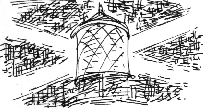 white undersides for a second or two, during, and immediately before and after, the passage of the beam. It's a clear moonless night and, at first I don't recognise them as birds, assuming that I've glimpsed some kind of shooting star. white undersides for a second or two, during, and immediately before and after, the passage of the beam. It's a clear moonless night and, at first I don't recognise them as birds, assuming that I've glimpsed some kind of shooting star.With my hood up against the wind, I'm not very visible from behind and I get a glancing blow from a shearwater as it glides in towards its burrow.
Gulls' toysAlthough shearwater wings and the remains or rabbits are scattered around the island, there is a lack of human litter; the bottles, cans and crisp packets, the builder's rubble and old tyres, that you'd expect to find in any beautiful stretch of countryside on the mainland, are missing. But the gulls collect shiny and coloured objects and bring them back to the island. These include light bulbs, a limb from a plastic doll, a radio valve, sweet wrappers and a plastic toy soldier.
|
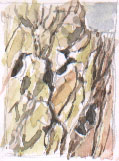 The north and south coasts of the island are strikingly different because of the tilt of the strata. The layers are upended, like the pages of a book that is being opened. On parts of the southern shore they slope like a house roof, while, here on the northern shore they tilt out over the bays. Guillemots, which look like little brownish penguins, crowd together on ledges. The black and white Razorbills prefer to be on their own isolated handkerchief-sized ledges.
The north and south coasts of the island are strikingly different because of the tilt of the strata. The layers are upended, like the pages of a book that is being opened. On parts of the southern shore they slope like a house roof, while, here on the northern shore they tilt out over the bays. Guillemots, which look like little brownish penguins, crowd together on ledges. The black and white Razorbills prefer to be on their own isolated handkerchief-sized ledges. In a gully on the clifftop there is a scattering of remains of Manx shearwaters. Usually it is just the wings that are left. Any that are unable to take off before dawn are likely to fall prey to gulls. The gulls like to take their food to eat near fresh water.
In a gully on the clifftop there is a scattering of remains of Manx shearwaters. Usually it is just the wings that are left. Any that are unable to take off before dawn are likely to fall prey to gulls. The gulls like to take their food to eat near fresh water.